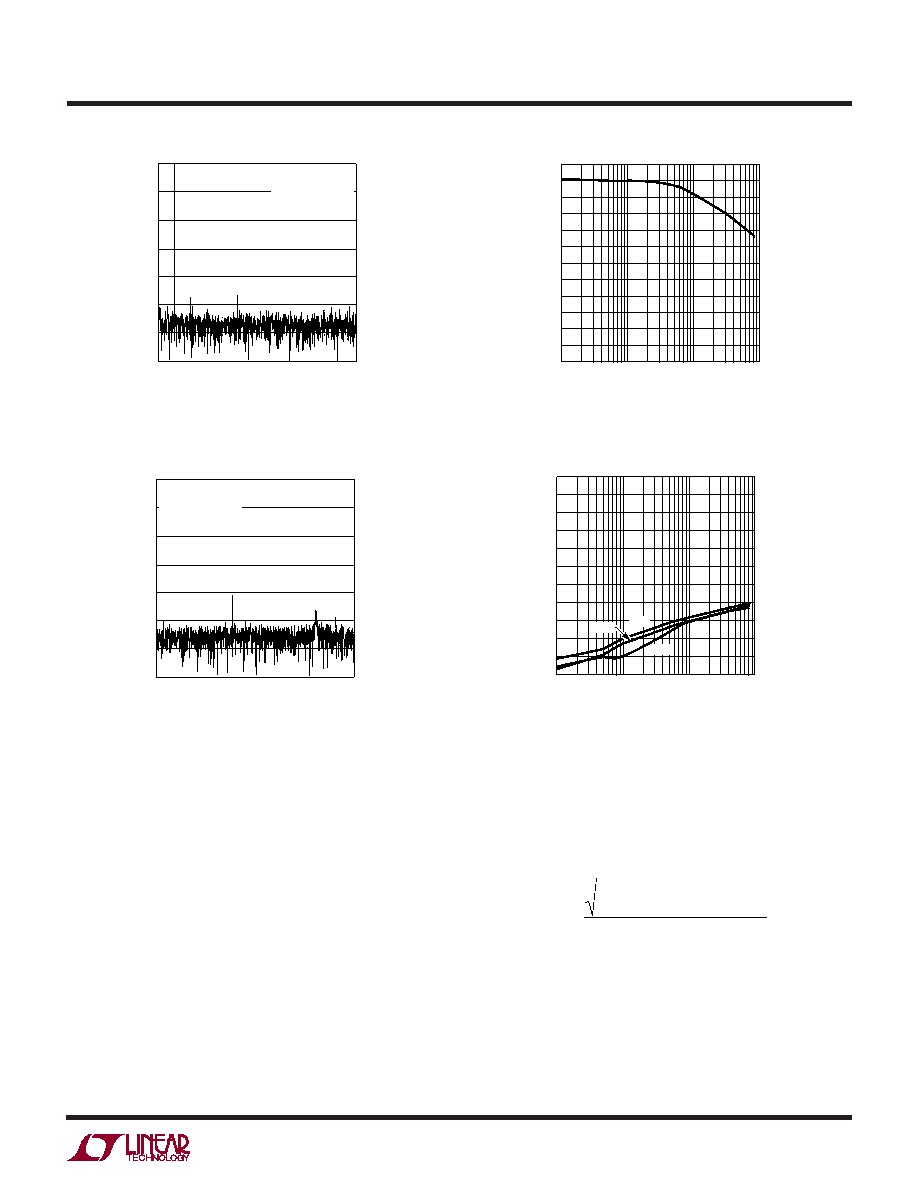- 您现在的位置:买卖IC网 > Sheet目录2003 > LTC1411IG#TRPBF (Linear Technology)IC A/D CONV 14BIT 2.5MSPS 36SSOP

9
LTC1411
1411f
Effective Number of Bits
The effective number of bits (ENOBs) is a measurement of
the resolution of an ADC and is directly related to the
S/(N + D) by the equation:
ENOBS = [S/(N + D) – 1.76]/6.02
where S/(N + D) is expressed in dB. At the maximum
sampling rate of 2.5MHz the LTC1411 maintains good
ENOBs up to the Nyquist input frequency of 1.25MHz.
Refer to Figure 3.
Total Harmonic Distortion
Total harmonic distortion (THD) is the ratio of the RMS
sum of all harmonics of the input signal to the fundamental
APPLICATIO S I FOR ATIO
WU
UU
INPUT FREQUENCY (kHz)
0
–60
–40
0
1411 G14
–80
–100
–120
–140
–20
AMPLITUDE
(dB)
SINAD = 78.8dB
SFDR = 95dB
fSAMPLE = 2.5MHz
fIN = 100kHz
1000
250
500
750
1250
Figure 2a. LTC1411 Nonaveraged, 4096 Point FFT,
Input Frequency = 100kHz
itself. The out-of-band harmonics alias into the frequency
band between DC and half the sampling frequency. THD is
expressed as:
THD
VV
V
N
=
++
+…
20
2
3
2
4
22
1
log
where V1 is the RMS amplitude of the fundamental fre-
quency and V2 through VN are the amplitudes of the
second through Nth harmonics. THD vs input frequency is
shown in Figure 4. The LTC1411 has good distortion
performance up to the Nyquist frequency and beyond.
FREQUENCY (kHz)
0
–40
–20
0
1000
1411 G15
–60
–80
250
500
750
1250
–100
–120
–140
AMPLITUDE
(dB)
SINAD = 75dB
SFDR = 81dB
fSAMPLE = 2.5MHz
fIN = 1MHz
Figure 2b. LTC1411 4096 Point FFT,
Input Frequency = 1MHz
Figure 3. Effective Bits and Signal/(Noise + Distortion)
vs Input Frequency
INPUT FREQUENCY (kHz)
10
38
S/(N
+
D)
(dB)
EFFECTIVE
BITS
50
62
100
1000
10000
1411 TA02
26
14
86
74
32
44
56
20
80
68
10
14
12
13
11
Figure 4. Distortion vs Input Frequency
INPUT FREQUENCY (kHz)
10
–80
DISTORTION
(dB)
–60
–40
100
1000
10000
1411 G03
–100
–110
0
–20
–90
–70
–50
–10
–30
2ND
3RD
THD
发布紧急采购,3分钟左右您将得到回复。
相关PDF资料
LTC1412IG#TR
IC ADC 12BIT 3MSPS SAMPLE 28SSOP
LTC1414IGN#TRPBF
IC A/D CONV 14BIT SAMPLNG 28SSOP
LTC1415CG#TRPBF
IC A/D CONV 12BIT SAMPLNG 28SSOP
LTC1416IG#TR
IC ADC 14BIT 400KSPS SMPL 28SSOP
LTC1417AIGN#TR
IC ADC 14BIT 400KSPS SMPL 16SSOP
LTC1418ACG#TRPBF
IC A/D CONV 14BIT SRL&PAR 28SSOP
LTC1419AISW#TRPBF
IC A/D CONV 14BIT SAMPLNG 28SOIC
LTC1420IGN#TRPBF
IC ADC 12BIT 10MSPS SAMPL 28SSOP
相关代理商/技术参数
LTC1412CG
功能描述:IC A/D CONV 12BIT SAMPLNG 28SSOP RoHS:否 类别:集成电路 (IC) >> 数据采集 - 模数转换器 系列:- 标准包装:1,000 系列:- 位数:12 采样率(每秒):300k 数据接口:并联 转换器数目:1 功率耗散(最大):75mW 电压电源:单电源 工作温度:0°C ~ 70°C 安装类型:表面贴装 封装/外壳:24-SOIC(0.295",7.50mm 宽) 供应商设备封装:24-SOIC 包装:带卷 (TR) 输入数目和类型:1 个单端,单极;1 个单端,双极
LTC1412CG#PBF
功能描述:IC A/D CONV 12BIT SAMPLNG 28SSOP RoHS:是 类别:集成电路 (IC) >> 数据采集 - 模数转换器 系列:- 标准包装:1 系列:microPOWER™ 位数:8 采样率(每秒):1M 数据接口:串行,SPI? 转换器数目:1 功率耗散(最大):- 电压电源:模拟和数字 工作温度:-40°C ~ 125°C 安装类型:表面贴装 封装/外壳:24-VFQFN 裸露焊盘 供应商设备封装:24-VQFN 裸露焊盘(4x4) 包装:Digi-Reel® 输入数目和类型:8 个单端,单极 产品目录页面:892 (CN2011-ZH PDF) 其它名称:296-25851-6
LTC1412CG#TR
功能描述:IC ADC 12BIT 3MSPS SAMPLE 28SSOP RoHS:否 类别:集成电路 (IC) >> 数据采集 - 模数转换器 系列:- 标准包装:1,000 系列:- 位数:12 采样率(每秒):300k 数据接口:并联 转换器数目:1 功率耗散(最大):75mW 电压电源:单电源 工作温度:0°C ~ 70°C 安装类型:表面贴装 封装/外壳:24-SOIC(0.295",7.50mm 宽) 供应商设备封装:24-SOIC 包装:带卷 (TR) 输入数目和类型:1 个单端,单极;1 个单端,双极
LTC1412CG#TRPBF
功能描述:IC A/D CONV 12BIT SAMPLNG 28SSOP RoHS:是 类别:集成电路 (IC) >> 数据采集 - 模数转换器 系列:- 标准包装:1,000 系列:- 位数:12 采样率(每秒):300k 数据接口:并联 转换器数目:1 功率耗散(最大):75mW 电压电源:单电源 工作温度:0°C ~ 70°C 安装类型:表面贴装 封装/外壳:24-SOIC(0.295",7.50mm 宽) 供应商设备封装:24-SOIC 包装:带卷 (TR) 输入数目和类型:1 个单端,单极;1 个单端,双极
LTC1412IG
功能描述:IC A/D CONV 12BIT SAMPLNG 28SSOP RoHS:否 类别:集成电路 (IC) >> 数据采集 - 模数转换器 系列:- 标准包装:1,000 系列:- 位数:12 采样率(每秒):300k 数据接口:并联 转换器数目:1 功率耗散(最大):75mW 电压电源:单电源 工作温度:0°C ~ 70°C 安装类型:表面贴装 封装/外壳:24-SOIC(0.295",7.50mm 宽) 供应商设备封装:24-SOIC 包装:带卷 (TR) 输入数目和类型:1 个单端,单极;1 个单端,双极
LTC1412IG#PBF
功能描述:IC A/D CONV 12BIT SAMPLNG 28SSOP RoHS:是 类别:集成电路 (IC) >> 数据采集 - 模数转换器 系列:- 标准包装:1,000 系列:- 位数:12 采样率(每秒):300k 数据接口:并联 转换器数目:1 功率耗散(最大):75mW 电压电源:单电源 工作温度:0°C ~ 70°C 安装类型:表面贴装 封装/外壳:24-SOIC(0.295",7.50mm 宽) 供应商设备封装:24-SOIC 包装:带卷 (TR) 输入数目和类型:1 个单端,单极;1 个单端,双极
LTC1412IG#TR
功能描述:IC ADC 12BIT 3MSPS SAMPLE 28SSOP RoHS:否 类别:集成电路 (IC) >> 数据采集 - 模数转换器 系列:- 标准包装:1,000 系列:- 位数:12 采样率(每秒):300k 数据接口:并联 转换器数目:1 功率耗散(最大):75mW 电压电源:单电源 工作温度:0°C ~ 70°C 安装类型:表面贴装 封装/外壳:24-SOIC(0.295",7.50mm 宽) 供应商设备封装:24-SOIC 包装:带卷 (TR) 输入数目和类型:1 个单端,单极;1 个单端,双极
LTC1412IG#TRPBF
功能描述:IC A/D CONV 12BIT SAMPLNG 28SSOP RoHS:是 类别:集成电路 (IC) >> 数据采集 - 模数转换器 系列:- 标准包装:1,000 系列:- 位数:12 采样率(每秒):300k 数据接口:并联 转换器数目:1 功率耗散(最大):75mW 电压电源:单电源 工作温度:0°C ~ 70°C 安装类型:表面贴装 封装/外壳:24-SOIC(0.295",7.50mm 宽) 供应商设备封装:24-SOIC 包装:带卷 (TR) 输入数目和类型:1 个单端,单极;1 个单端,双极